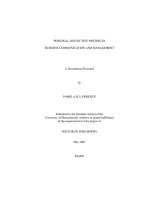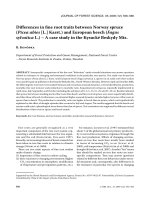The differences in business communication styles between Japanese and Vietnamese
Bạn đang xem bản rút gọn của tài liệu. Xem và tải ngay bản đầy đủ của tài liệu tại đây (213.34 KB, 18 trang )
Accumulative Report
The differences
in business communication styles
between Japanese and Vietnamese
Linh Pham
Page 1
Accumulative Report
Table of Contents
Chapter I: Introduction ........................................................................................................ 4
Chapter II: Content .............................................................................................................. 5
2.1 Background Concepts ................................................................................................ 5
2.1.1 Definition of communication styles ................................................................... 5
2.1.2 Common business communication styles ........................................................... 6
2.2 Three main differences in business communication styles between Japanese and
Vietnamese ...................................................................................................................... 6
a. Gestures ................................................................................................................... 6
b. Eye contact .............................................................................................................. 9
c. Speech .................................................................................................................... 12
Chapter III: Conclusion and recommendations ................................................................. 16
References ......................................................................................................................... 17
Linh Pham
Page 2
Accumulative Report
Tables
Table 2.2.1. The smile scenes of characters in Japanese films……………………………11
Table 2.2.2. The smile scenes of characters in Vietnamese films…………………………12
Table 2.2.3. The eye contact scenes of characters in Japanese films……………………...13
Table 2.2.4. The eye contact scenes of characters in Vietnamese films…………………..14
Table 2.2.5. The expressing complaints scenes of characters in Japanese films………….16
Table 2.2.6. The expressing complaints scenes of characters in Vietnamese films……….17
Linh Pham
Page 3
Accumulative Report
Chapter I: Introduction
Physical borders between nations, particularly in business, are disappearing in the 21st
century as a result of globalization, and people from various racial and cultural
backgrounds gather together to work in order to help their businesses to gain achieved their
goals. Cultural norms and assumptions are becoming more permeable and communication
barriers cannot be avoided. This could have an impact on how well the multicultural team's
project turns out. As a result, international organizations emphasize having strong
communication abilities with people from various cultural backgrounds.
These days, opportunities to collaborate and engage with people and businesses in Japan
have been made strong possible by globalization for Vietnamese businesses. Although
Japan and Viet Nam are located in Asia, each country also has its own unique features of
business communication styles. Therefore, if we do not learn how to adapt to variety, we
will lose out on the amazing opportunities of the Industrial Revolution 4.0. This is also the
reason why the writer raises the topic: “The differences in business communication styles
between Japanese and Vietnamese” which helps us to learn how to interact with others and
build bridges to trust respect and understanding across cultures in the workplace. In this
paper, there are three key differences including gestures, eye contact, and speech will be
clarified.
Linh Pham
Page 4
Accumulative Report
Chapter II: Content
2.1 Background Concepts
There are some key terms that used by the writer in this paper such as communication style,
and some common business communication styles. Therefore, the writer is going to clarify
the definition of each one in order to the reader gets them clearly.
2.1.1 Definition of communication styles
According to Luthra & Dahiya (2015), communication styles are the ways to interact with
others and it is used to share information and beliefs, exchange ideas and feelings, make
plans, and solve problems.
Every culture has its own distinctive communication style; even people in the same
culture do not share the same communication style (Du Plooy-Cilliers & Louw, 2003)
and people in various cultures will have different understandings of the same message.
2.1.1.1 Gestures
According to Oxford Learner's Dictionaries, a gesture is a movement that you make with
your hands, your head, or your face to show a particular meaning.
2.1.1.2 Eye contact
Eatough (2021) defined that eye contact is what happens when two people look at each
other’s eyes at the same time. This is a type of nonverbal communication that humans use
to communicate many forms of emotions.
There are two forms of eye contact: direct and indirect eye contact.
• Direct eye contact is when two people look directly into each other's eyes.
• Indirect eye contact is looking away or off to the side. Usually, people will look at
another part of someone’s face, such as their chin or nose.
Linh Pham
Page 5
Accumulative Report
2.1.1.3 Speech
Based on The Random House Unabridged Dictionary, speech is the ability to express
thoughts and emotions through vocal sounds and gestures. The act of doing this is also
known as speech.
Speech is something only humans are capable of doing and this ability has contributed
greatly to humanity’s ability to develop civilization. Speech allows humans to
communicate much more complex information than animals can.
2.1.2 Common business communication styles
According to Cook (2015), there are four business communication styles that we often
follow and reference. And then, the writer will mention the definition below:
•
Passive communication is a style that implies saying or doing nothing when faced
with a social conflict or distressing situation.
•
Aggressive communication refers to physical or verbal aggression, whereby overt
hostility is expressed in a way intended to deliberately hurt others.
•
Passive-aggressive communication is a style whereby people covertly display
hostility or aggression. For example, they might deliberately lose or forget
something, or show up late to meet someone with whom they are angry.
•
Assertive communication is considered the ideal style. It involves openly and
honestly expressing one’s feelings without using shame, blame, or put downs and
making simple and clear requests of others.
2.2 Three main differences in business communication styles between Japanese and
Vietnamese
a. Gestures
In 2017, Hooray stated that a smile is the world’s most powerful gesture. Japanese
businessmen rarely smile (Nakane, 1974) and maintain the same posture during
conversation or meeting. Therefore, their minor smile can mean different feelings. In
Linh Pham
Page 6
Accumulative Report
contrast, the Vietnamese value delicacy and harmony so they usually do not communicate
directly or speak out their mind and they also have the habit to think twice before they
speak. Instead, they smile to keep the peace since smile is an important part of Vietnamese
people and they can smile in the least expected situations (Poitvin, Stedman & Davis,
2005).
The table below are some examples of using smile’s aim of characters in Japanese films.
what aim do they smile with their partners?
Films
1. Shitamachi
Timestamp
16:45
To show
To keep the peace
To just
different
when they disagree
laugh it
feelings
with the others
off
x
Rocket
(2011)
2. Kaki Koba
7:53- 8:14
x
(2015)
3. Shomuni
(1998)
4. Hataraki
Episode 6
x
17:33-17:56
29:35
x
(2007)
Linh Pham
Page 7
Accumulative Report
5. Nakanai to
17:33
x
Kimeta Hi
(2010)
Table 2.2.1. The smile scenes of characters in Japanese films
The table below are some examples of using smile’s aim of characters in Vietnamese
films.
what aim do they smile with their partners?
Films
1.Tèo Em
Timestamp
3:57-4:01
x
To show
To keep the peace when
To just
different
they disagree with the
laugh it
feelings
others
off
x
(2013)
2. Chị Mẹ
Episode 4
x
x
x
x
Học Yêu
7:23- 7:40
(2012)
3. 11 tháng
Episode 38
5 ngày
32:38
(2021)
Linh Pham
Page 8
Accumulative Report
4.Tình yêu
Episodes 20
và
1:09
x
tham vọng
(2020)
5.Hoa
Episodes 2
hồng trên
31:19- 31:31
x
ngực trái
(2020)
Table 2.2.2. The smile scenes of characters in Vietnamese films
As we can see in the tables above, only 10% of Vietnamese smile with their partners to
show different feelings while up to 80% of Japanese do that. Moreover, the Japanese often
do not show their feelings for others know, so we rarely see their smile. Besides, there are
10% of Japanese smile with their partners to keep the peace when they disagree with others
while 50% of Vietnamese are willing to do this job. About the data on smiling with the
partners, there has no Japanese who use it to just laugh it off while 30% of Vietnamese use
it as a tool to beat around the bush. In conclusion, it is so really hard to realize the
Japanese’s emotions from their smile while the Vietnamese often use their smile to solve
any problems.
b. Eye contact
Hartley (2015) states that the Japanese tend to avoid direct eye contact ‘unless a superior
wants to admonisha subordinate’. To them, making eye contact with another person during
a conversation is considered rude. By contrast, both direct and indirect eye contact is used
in Vietnam. According to Scroope (2021), it is respectful to defer eye contact away from
those who are of the opposite gender, of a higher status, or older than you. Usually, you
Linh Pham
Page 9
Accumulative Report
can look at other parts of someone’s face such as their chin, or nose. However, direct eye
contact is held and expected with one's colleague.
The table below are some examples of using eye contact’s subjects of characters in
Japanese films.
Who do they often use eye contact with?
Films
Timestamp
Colleague Boss Customer Employee
1. Shitamachi Rocket
43:47-53:45
x
x
(2011)
2. Kaki Koba
10:15-12:10
x
(2015)
3. Shomuni
11:41
x
x
(1998)
4. Hataraki
44:36
x
6:37- 6:56
x
(2007)
5. Nakanai to Kimeta Hi
(2010)
Table 2.2.3. The eye contact scenes of characters in Japanese films
Linh Pham
Page 10
Accumulative Report
The table below are some examples of using eye contact’s subjects of characters in
Vietnamese films.
Who do they often use eye contact with?
Films
Timestamp
Colleague Boss Customer Employee
1.Tèo Em
11: 50- 12:09
x
2. Chị Mẹ Học Yêu
Episodes 10
x
(2012)
12:09- 13:14
3. 11 tháng 5 ngày
34:46- 45:05
x
4.Tình yêu và
Episodes 14
x
tham vọng
29:13- 31:22
x
(2013)
x
x
(2021)
(2020)
5.Hoa hồng trên
19:09- 21:11
x
ngực trái
(2020)
Table 2.2.4. The eye contact scenes of characters in Vietnamese films
Linh Pham
Page 11
Accumulative Report
As we can see in the table above, it illustrates that only 10% of Japanese use eye contact
with their colleagues while up to 50% of Vietnamese do that. In addition, using eye contact
with the boss doesn’t have more distance. Specifically, only 10% of Japanese and 20% of
Vietnamese often keep eye contact with people of higher status because they consider that
this can show confidence in them. Furthermore, the percentage of using eye contact with
customers between Japan and Viet Nam has no any difference. It is clear that 10% of
Japanese and 20% of Vietnamese do. Moreover, most Japanese (70%) often tend to make
eye contact with the staff more than the Vietnamese (10%). To sum up, the Japanese rarely
make eye contact with others because they considered that it is a violation of personal space
while the Vietnamese tend to use eye contact with people as a way to show their
confidence.
c. Speech
Beer (2022) confirms that in a complaining and conflict situation, Japanese people always
keep silent or use humble language that signals but does not express their anger outright.
On the other hand, when Vietnamese employees have some complaints, they often keep
silent or make written complaints to manager. (HR Solutions Vietnam, 2010).
The table below are some examples of expressing complaints of characters in Japanese
films.
How do they express their complaints?
Films
1. Shitamachi
Timestamp
8:51-9:55
Keep
Use humble
Make written
silent
language
complaints to manager
x
Rocket
Linh Pham
Page 12
Accumulative Report
(2011)
2. Kaki Koba
24:25-
x
x
25:16
(2015)
3. Shomuni
21:03-
x
24:28
(1998)
4. Hataraki
23:09-
x
24:23
(2007)
5. Nakanai to
12:03-
Kimeta Hi
13:15
x
x
(2010)
Table 2.2.5. The expressing complaints scenes of characters in Japanese films
The table below are some examples of expressing complaints of characters in Vietnamese
films.
How do they express their complaints?
Films
Linh Pham
Timestamp
Keep
Use humble
Make written complaints
silent
language
to manager
Page 13
Accumulative Report
1.Tèo Em
11:32-19:51
x
(2013)
2. Chị Mẹ
44:15-
Học Yêu
45:36
x
x
x
x
(2012)
3. 11 tháng 5
31:03-
ngày
54:48
(2021)
4.Tình yêu và
tham vọng
43:39-
x
44:03
(2020)
5.Hoa hồng
14:22-
trên
23:55
x
ngực trái
(2020)
Table 2.2.6. The expressing complaints scenes of characters in Vietnamese films
As we can see in the tables above, only 40% of Vietnamese keep silent in the conflict
situation while up to 80% of Japanese do that. In addition, the percentage of using humble
language in Japan is higher than 10% in Vietnam. Moreover, regarding the data on making
Linh Pham
Page 14
Accumulative Report
written complaints to managers, there has been no Japanese use it while 50% of Vietnamese
use it as a tool to show the things that they are not satisfied with. In short, in a conflict, the
Japanese always consider maintaining relationships, so they do not write any complaints
to the manager. Besides, they often keep silent and sometimes use humble language. On
the contrary, the Vietnamese often choose to keep silent and then make written complaints
to the manager because they need to have a person who can solve the conflicts for them.
Linh Pham
Page 15
Accumulative Report
Chapter III: Conclusion and recommendations
International communication is increasing as a result of globalization's constant progress.
During this process, problems resulting from their various communication styles,
especially in business are discovered in increasing numbers. It is crucial to comprehend
these distinctions in order to prevent misunderstanding, foster cooperation, and avoid
conflict. This paper compares the contrasts between Japanese and Vietnamese business
communication styles to achieve this goal. Further research into this area reveals factors
that contribute to these distinctions such as gestures, eye contact, and speech.
Understanding all of these that have been mentioned above would significantly raise
awareness of cross-cultural communication, which would not only improve international
communication between citizens of these two nations but also lay the groundwork for
greater international understanding and a more peaceful world.
Linh Pham
Page 16
Accumulative Report
References
Beer, J. (2022).
Japan: Conflict & Control. Lansdowne: USA. Retrieved from
/>Cook, M. N. (2015). Transforming Teen Behavior: Parent-Teen Protocols for
Psychosocial Skills Training. Academic Press.
/>Du Plooy-Cilliers, F., & Louw, M. (2003). Interpersonal Communication. Heinemann
Educational Publishers, Cape Town, South Africa.
Eatough, E. (2021). Eye contact is important (crucial really) in communication. San
Francisco: USA. Retrieved from />Hooray. (2017). The science behind the world’s most powerful gesture, the smile. Retrieved
from
/>
powerful-gesture-thesmile/#:~:text=%E2%80%93%20Mother%20Teresa,spirit%20of%20joy%20is%20p
resent.
Hartley, P. (2015). Business Communication: Rethinking your professional practice for the
post-digital age. Routledge, New York, USA.
HR Solutions Vietnam. (2010). HR Survival Guide For Foreign Managers In Vietnam.
Euro
Charm
VN,
viewed
25th
September
2014.
Retrieved
from
/>Hunt, P. C. (2002). An introduction to Vietnamese culture for rehabilitation service
providers in the U.S. In Stone, J. (Ed.), “CIRRIE Monograph Series”, Center for
International Rehabilitation Research Information and Exchange, Buffalo, New York,
USA.
Linh Pham
Page 17
Accumulative Report
Luthra, A., & Dahiya, K. (2015). Organizational Communication and Management
Effectiveness: An analytical Study at Various Managerial Levels.
International
Journal of Management & Business Studies, 5(3), 2230–9519. Retrieved from
/>Nakane, C. (1974). The social system reflected in interpersonal communication.
IN Condon, J.C. & Saito, M. (Edns.), Intercultural Encounters with Japan (pp. 124198). Simul Press, Tokyo, Japan.
Poitvin, C., Stedman, N. & Davis, P. (2005). Dos & don'ts in Vietnam. Book Promotion
and Service, Bangkok, Thailand.
Scroope,
C.
(2021).
Japanese
Culture:
Communication.
Retrieved
from
/>
Linh Pham
Page 18









